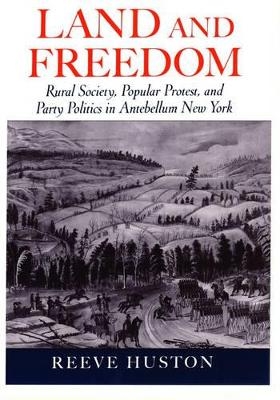
Land and Freedom
Rural Society, Popular Protest, and Party Politics in Antebellum New York
Seiten
2000
Oxford University Press Inc (Verlag)
978-0-19-513600-5 (ISBN)
Oxford University Press Inc (Verlag)
978-0-19-513600-5 (ISBN)
In the early 19th century, most of New York's farmland was controlled by a few families. In 1839, some tenants created a movement to destroy the estates and to redistribute the land. This work brings to life the voices of antebellum northern farmers as they debated social and political issues.
During the early nineteenth-century, two million acres of New York's farmland were controlled by a handful of great families. Along the Hudson Valley and across the Catskills lay the great estates of the Van Rensselaers, the Livingstons, and a dozen lesser landlords. Some two hundred and sixty thousand men, women, and children-a twelfth of the population of New York, the nation's most populous state-worked this land as tenants. Beginning in 1839, these tenants created a movement dedicated to destroying the estates and distributing the land to those who farmed it. The "anti-rent" movement quickly became one of the most powerful and influential movements of the antebellum era.
The anti-renters raised issues that lay at the heart of America's republican experiment: the distribution of land, the nature of democracy, and the meaning of freedom. In doing so, they left an indelible mark on politics and public ideals in both New York and the nation. They influenced and bitterly divided both major political parties, and helped create the Republican party. Moreover, they shaped the ideas, policies, and careers of such national leaders as Martin Van Buren, Silas Wright, Horace Greeley, and William Seward.
Deftly interweaving an engaging narrative history with broad-ranging social and political analysis, Land and Freedom brings to life the voices of antebellum northern farmers as they debated the critical social and political issues of their day. It grounds those debates in a detailed analysis of social and political change on New York's estates, and demonstrates the impact of farmers' ideas and initiatives on the broader social and political order. In doing so, it offers new insights into the social and political thought of northeastern farmers, the extent and limits of popular political power under the Jacksonian political order, and the social origins of free-labor ideology and the Republican party.
During the early nineteenth-century, two million acres of New York's farmland were controlled by a handful of great families. Along the Hudson Valley and across the Catskills lay the great estates of the Van Rensselaers, the Livingstons, and a dozen lesser landlords. Some two hundred and sixty thousand men, women, and children-a twelfth of the population of New York, the nation's most populous state-worked this land as tenants. Beginning in 1839, these tenants created a movement dedicated to destroying the estates and distributing the land to those who farmed it. The "anti-rent" movement quickly became one of the most powerful and influential movements of the antebellum era.
The anti-renters raised issues that lay at the heart of America's republican experiment: the distribution of land, the nature of democracy, and the meaning of freedom. In doing so, they left an indelible mark on politics and public ideals in both New York and the nation. They influenced and bitterly divided both major political parties, and helped create the Republican party. Moreover, they shaped the ideas, policies, and careers of such national leaders as Martin Van Buren, Silas Wright, Horace Greeley, and William Seward.
Deftly interweaving an engaging narrative history with broad-ranging social and political analysis, Land and Freedom brings to life the voices of antebellum northern farmers as they debated the critical social and political issues of their day. It grounds those debates in a detailed analysis of social and political change on New York's estates, and demonstrates the impact of farmers' ideas and initiatives on the broader social and political order. In doing so, it offers new insights into the social and political thought of northeastern farmers, the extent and limits of popular political power under the Jacksonian political order, and the social origins of free-labor ideology and the Republican party.
Reeve Huston is Assistant Professor of History at the University of Arizona, Tucson.
Introduction ; 1. Landlords and Tenants, 1785-1820 ; 2. Toward Crisis, 1819-1840 ; 3. The Fall of the House of Van Rensselaer, 1819-1839 ; 4. Origins of the Anti-Rent Movement, 1839-1844 ; 5. Land and Freedom, 1844-1846 ; 6. The Parties and "The People," 1844-1846 ; 7. "A Right to the Soil" ; 8. Fast Fish and the Temple of the Philistines ; 9. Toward Free Labor ; Statistical Appendix
| Erscheint lt. Verlag | 1.11.2000 |
|---|---|
| Zusatzinfo | halftones, 3 maps |
| Verlagsort | New York |
| Sprache | englisch |
| Maße | 159 x 240 mm |
| Gewicht | 531 g |
| Themenwelt | Geschichte ► Allgemeine Geschichte ► Neuzeit (bis 1918) |
| Geisteswissenschaften ► Geschichte ► Regional- / Ländergeschichte | |
| Geschichte ► Teilgebiete der Geschichte ► Kulturgeschichte | |
| Sozialwissenschaften ► Politik / Verwaltung | |
| Sozialwissenschaften ► Soziologie | |
| Wirtschaft ► Betriebswirtschaft / Management ► Rechnungswesen / Bilanzen | |
| ISBN-10 | 0-19-513600-4 / 0195136004 |
| ISBN-13 | 978-0-19-513600-5 / 9780195136005 |
| Zustand | Neuware |
| Haben Sie eine Frage zum Produkt? |
Mehr entdecken
aus dem Bereich
aus dem Bereich
Europa 1848/49 und der Kampf für eine neue Welt
Buch | Hardcover (2023)
DVA (Verlag)
48,00 €
Giordano Bruno - ein ketzerisches Leben
Buch | Hardcover (2024)
C.H.Beck (Verlag)
29,90 €


